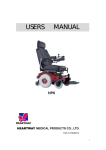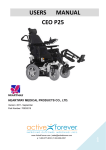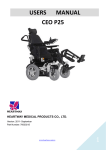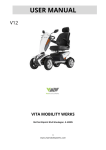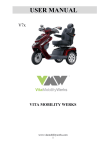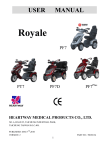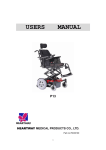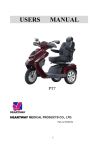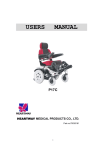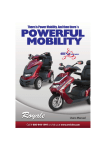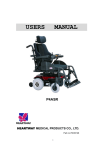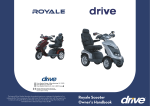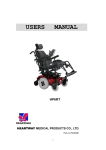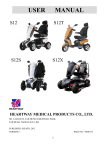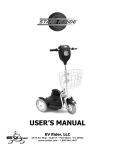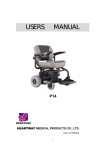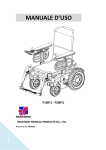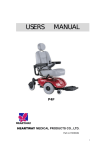Download USERS MANUAL - Mobility Scooters Direct
Transcript
USERS MANUAL P20CL HEARTWAY MEDICAL PRODUCTS CO., LTD. Part no: 70030176 1 COMPONENTS Your power wheelchair is shipped partially dissembled to protect it during shipping. After unpacking, please check whether you have received the following main components as our standard specification (See Fig.1). 1. 2. 3. 4. Main frame with motor Headrest Seat /Thigh Armrest(right) 5. Armrest(left) 6. Footrest( left&right) 7. Controller 2 7 5 4 3 6 1 (Fig 1) 2 SAFETY INSTRUCTION Operation of Chair 1. Always ensure that the power is switched off when getting in or out of the wheelchair. This will eliminate the possibility of accidentally activating the joystick and causing injury to yourself or others. 2. Always check that the drive wheels are engaged (drive mode) before driving. 3. Set the speed control knob according to your driving ability and the environment in which you are going to operate. We recommend that you keep your speed at the slowest position (fully press the deceleration button) until you are familiar with the driving characteristics of the vehicle. We also recommend that you use the slowest speed when using your power wheelchair indoors. 4. Always reduce your speed when making sharp turns. 5. Do not switch off the power when the wheelchair is still moving forward. This will bring the chair to an extremely abrupt stop. 6. Avoid jerky stop/start motions as the will result in excessive current draw from the batteries, increased tire wear and the rapid wearing of the gear boxes and motors. 7. To brake in an emergency, simply release the joystick. Ramps and Curbs 8. When driving up or down ramps, be sure to check that the angle of the slope is less than 10 degrees (slopes about 1/6). Also check that ramp surface is roughened to prevent slipping. Never drive across the slope or turn sharply on a slope. 9. When driving up curbs, always check the height of the curb to ensure that it does not exceed 1-1/2” (40mm) height. Transfers, Reaching and Bending 10. Transferring on and off the P20RTL requires a good sense of balance. To eliminate the possibility of injury, We recommend performing the following tasks before attempting a transfer: → Position chair so that the distance between your power chair and the object to which you are transferring is close enough for a safe transfer. 3 → Turn the power off → Ensure that your power chair not in freewheel mode. → Flip up or remove armrests → Flip up footplate or remove footrests → Turn both caster wheels towards the transfer direction to improve power chair stability during transfer. 11. When reaching, bending or leaning while seated on your power chair, make sure that you maintain a stable center of gravity to keep the power chair from tipping. General Always use a seat belt, and keep feet on the footplate at all the time. 12. For safety reasons, make sure that your weight does not exceed the recommended weight limit of the wheelchair. Consult your dealer for the specified weight limits for your particular model. 13. Do not attempt to lift or move a power chair by any of its removable parts. Personal injury and damage to the power chair may result. 14. Do not stand on the footplate directly. 15. Never try to use your wheelchair beyond its limitations as described in this manual. 16. Do not operate your vehicle if it is not functioning properly. 17. Do not connect any electrical or mechanical device to the vehicle. Failure to obey this instruction may result in injury and will void the warranty. 18. Never use electronic radio transmitters such as CB, walkie-talkies, portable computers or cellular phones while using the vehicle without first turning the vehicle off Use While Under The Influence Of Medication Or Alcohol 19. Check with your physician if you are taking any medication that may affect your ability to operate your power wheelchair safely. 20.Do not operate your vehicle while you are under the influence of alcohol, as this may impair your ability to operate your power chair in a safe manner. Electromagnetic interference (EMI) from Radio Wave Sources 1.The rapid development of electronics, especially in the area of communications, has saturated our environment with electromagnetic(EM) radio waves that are emitted by television, radio and communication signals. These EM wave are invisible and their strength increases as one 4 approaches the source. All electrical conductors act as antennas to the EM signals and, to varying degrees, all power wheelchairs and scooters are susceptible to electromagnetic interference(EMI). The interference could result in abnormal, unintentional movement and/or erratic control of the vehicle. The United States Food and drug Administration (FDA) suggests that the following statement be incorporated to the user’s manual for all power wheelchairs like the P20CL 2.Be aware of nearby transmitters such as radio or TV stations and try to avoid coming close to them. 3.If unintended movement or brake release occurs, turn the powered wheelchair off as soon as it is safe. 4.Be aware that adding accessories or components, or modifying the powered wheelchair, may make it more susceptible to interference from radio wave sources.(Note: It is difficult to evaluate the effect on the overall immunity of the powered wheelchair). 5.Report all incidents of unintended movement or brake release to the powered wheelchair manufacturer, and note whether there is a radio wave source nearby. Power wheelchairs and motorized scooters (in this section, both will be referred to as powered wheelchairs) may as susceptible to electromagnetic interference (EMI), which is interfering electromagnetic energy emitted from sources such as radio stations, TV stations, amateur radio (HAN) transmitter, two-way radios and cellular phones. The interference (from radio wave sources) can cause the powered wheelchair to release its brakes, move by itself or move in unintended directions. It can also permanently damage the powered wheelchair’s control system. The intensity of the EM energy can be measured in volts per meter(V/m).Each powered wheelchair can resist EMI up to a certain intensity. This is called “immunity level”. The higher the immunity level, the greater the protection. At this time, current technology is capable of providing at least 20 V/m of immunity level, which would provide useful protection against common sources of radiated EMI. Following the warnings listed below should reduce the chance of unintended brake release or powered wheelchair movement that could result in serious 5 injury: Do not turn on hand-held personal communication devices such as citizens band (CB) radios and cellular phones while the powered wheelchair is turned on. TURN OFF YOUR POWERED WHEELCHAIR AS SOON AS POSSIBLE WHEN EXPERIENCING THE FOLLOWING: ‧ Unintentional motions ‧ Unintended or uncontrollable direction. ‧ Unexpected brake release The FDA has written to the manufacturers of power wheelchairs asking them to test new products to be sure they provide a reasonable degree of immunity against EMI. The FDA requires that a powered wheelchair should have an immunity level at least 20 V/m, which provides a reasonable degree of protection against more common sources of EMI. The higher the immunity level, the greater the protection. Your powered wheelchair has an immunity level of 20 V/m which should protect against common sources of EMI. 6 ENVIRONMENTAL CONDITIONS Environmental conditions may affect the safety and performance of your power wheelchair. Water and extreme temperatures are the main elements that can cause damage and affect performance. A) Rain, Sleet and Snow If exposed to water, your power wheelchair is susceptible to damage to electronic or mechanical components. Water can cause electronic malfunction or promote premature corrosion of electrical components and frame. B) Temperature Some of the parts of the power wheelchair are susceptible to change in temperature. The controller can only operate in temperature that range between 18℉(-8℃) and 122℉(50℃). At extreme low temperatures, the batteries may freeze, and your power wheelchair may not be able to operate. In extreme high temperatures, it may operate at slower speeds due to a safety feature of the controller that prevents damage to the motors and other electrical components. 7 ASSEMBLY INSTRUCTION 1.Installing the Saddle set and Seat Connection (Fig 2) (See Fig 2) point (both sides) in the main frame Slide the seat into the Connection points (#1)(See Fig 2), put down the saddle set and connect the front connection point and make sure that tighten the tension knob in the front connection point. (See Fig 3). Front connection point (Fig 3) 2-1 Install the skirt guards (#10,#11) Insert the skirt guard support tube into the bracket in the correct direction (See Fig 4). Tighten the adjusted knob. (Fig 5) Adjusted Knob (Fig 4) (Fig 5) 8 3. Installing the Headrest Loosen the lever of saddle set, put the headset (#2) into the clamp then fasten the lever. (See Fig10) Saddle set lever (Fig 10) 4.Installing the Footrest Insert the footrest (#6) into footrest frame with side direction (See Fig 11) then turn around 90 degree to correct direction (See Fig 12) and make sure the pin jumping into the correct position. (See Fig 13) (Fig 11) (Fig 12) (Fig 13) 4.Installing Joystick and connect cable to VR2 Controller Assemble the controller (#7) on right armrest bracket.(See Fig 14). Joystick (Fig 14) 9 ADJUSTMENTS FOR SEATING CONFORT To maximize seating comfort, your power wheelchair lets you adjust: →Armrest width →Controller position →Backrest angle →Headrest height A. Armrest Width Adjustment → Loosen the tension knob → slide the armrest frame to your desired width → tighten the tension knob.(See Fig 10) Note: The armrests of HP6 are total folding by manual operation. Tension Knob Armrest Frame (Fig 10) B. Controller Position Adjustment Note: Controller position adjustment You can adjust the controller position by manual. The controller supporter can swing from inside to outside. (See Fig 11) (Fig 11) C. Backrest Angle Adjustment Lift up the lever located the left side of the seat and 10 adjust the backrest position to your desired angle Note: There are 5 different angles range when you slightly adjust the backrest to fit yours comfortable seating from the 105° to 135°. D. Headrest Height Adjustment → press the button and lift up or down the headrest to your desired position → let the button lock into the corresponding notch. (See Fig 12) Note: There are 4 different positions to adjust your headrest height. Press this Button (Fig 12) 11 OPERATION The power wheelchair is simple to operate. However, we recommend that you read carefully the following instructions to become familiarized with your new vehicle. A Word of Caution: Before you turn the power on, always be aware of the environment that surrounds you to select your desired speed. For indoor environments we recommend that you select the slowest speed setting. For outdoor operation of this vehicle we recommend that you select a speed that is comfortable for you to control it safely. The following steps are required to operate your vehicle safely with the P18RTL controller (See Fig 24) (Fig 23) Battery Condition LED On/off button Horn button Hazard button Speed Button Decrease Left indicator Button & LED Headlight Button/ LED Speed Button Increase Right indicator Button & LED Tilt Button Joystick 1. On/off Button The on/off button applies power to the control system electronics, which in turn supply power to the wheelchair’s motors. Do not use the on/off button to stop the wheelchair unless there is an emergency. (If you do, you may shorten the life of the wheelchair drive components). 2. Horn Button The Horn will sound while this button is depressed. 3. Speed Decrease Button 12 This button decreases the maximum speed setting. Depending on the way the control system has been programmed a momentary screen may be displayed when the button is pressed. 4. Speed Increase Button This button increases the maximum speed setting. Depending on the way the control system has been programmed a momentary screen may be displayed when the button is pressed. 5. Mode Button The Mode button allows the user to navigate through the available operating Modes for the control system. The available modes are dependent on programming and the range of auxiliary output devices connected to the control system. 6. Profile Button The Profile button allows the user to navigate through the available Profiles for the control system. The number of available Profiles is dependent on how the control system is programmed. Depending on the way the control system has been programmed a momentary screen may be displayed when the button is pressed. 7. Hazard Warning Button and LED This button activates and de-activates the wheelchairs hazard lights. Depress the button to turn the hazards on and depress the button again to turn them off. When activated the hazard LED and the indicator LED’s will flash in sync with the wheelchair’s indicators. 8. Lights Button and LED This button activates and de-activates the wheelchairs lights. Depress the button to turn the lights on and depress the button again to turn them off. When activated the lights LED will illuminate. 9. Left Indicator Button and LED This button activates and de-activates the wheelchair’s left indicator. Depress the button to turn the indicator on and depress the button again to turn it off. When activated the left indicator LED will flash in sync with the wheelchair’s indicator. 10. Right Indicator Button and LED This button activates and de-activates the wheelchair’s right indicator. Depress the button to turn the indicator on and depress the button again to turn it off. When activated the right indicator LED will flash in sync with the wheelchair’s indicator. 13 A. Free-Wheeling: Because the motors are designed to engage the electromagnetic brakes when the vehicle is not in use or when the power is OFF, they also have a manual feature that allows them to “free-wheel”. Free-wheeling is accomplished by turning the free-wheeling levers to the freewheeling position.(See Fig 24) Warning ! →Never free-wheel your power wheelchair on a slope. →Never free-wheel the motors while operating your vehicle. →Always remember to engage the motors before turning the power back ON. (Fig 24) B. Electromagnetic Brakes: Your power wheelchair comes with an Electromagnetic Brakes., i.e. an automatic magnetic disc safety brake which is also known as Fail-Safe brake. The Electromagnetic Brakes are automatic and work when the power wheelchair is ON but in a steady state (i.e. Joystick is released to the neutral position), even when the chair is on a slope. The Electromagnetic Brakes will also be set whenever the power wheelchair is OFF, but the motor levers are in the engaged (vertical) position. Note: Please refer to the section titled to check brake in the Maintenance & Repair section in page 21 to make sure brakes are in good condition. C. Thermal Protection: Your power wheelchair controller is equipped with a safety system called thermal rollback. A built-in circuit monitors the temperature of the controller and motors, the controller reduces the motor voltage and speed of the power 14 wheelchair. The reduction of the speed allows the electrical components to cool down. Although your power wheelchair will resume its normal speed when the temperature returns to a safe level, we recommend that you turn the power off and wait for 5 minutes before restarting to allow the components to cool down if you find that you have lost speed suddenly. D. Main Circuit Breaker: The main circuit breakers reset button located near the seat of the back side on the main frame.(Fig 26) The main circuit breaker monitors the electric current drawn from the battery. It is a safety feature built in your power wheelchair for your extra safety. When the batteries and motors are heavily strained (e.g., from excessive loads),the main circuit breaker will trip to prevent damage to the motor and the electronics. If the circuit breaker trips, wait for approximately one minute and then depress the button to reset it. Then turn on the controller power, and continue normal operation. If the main circuit breaker continues to trip repeatedly, contact your authorized dealer. 15 BATTERY & CHARGER BATTERY We recommend that you use deep-cycle batteries that are sealed and maintenance free for your power wheelchair. Both sealed lead-acid (SLA) and gel cell are deep-cycle batteries and are similar in performance. Deep-cycle batteries are specifically designed to provide power, drain down, and then accept a relatively quick recharge. Lead-acid batteries should be charge as often as possible. Specification of the battery that we recommend: Type: Size: Voltage: Deep –cycle sealed lead-acid or gel cell 62Ah 12V each Amp Hours: 62 amp hours Depending on the use, terrain and driving conditions, the batteries will provide a range of 12-18 miles of travel. However, even if the power chair is not in use, we recommend that the batteries be charged periodically. Note: →Do not use any automotive batteries. They are not designed to handle a long, deep discharge and also are unsafe for use in power chairs. Battery Charger Instruction 8A 1. APPEARANCE Power Cord Output Plug to Battery Indicator : Green Flash : Power On Orange Flash : Pre Charge Orange : Charging Green&Orange Flash : Charged 80% Green : Full Charge Red Flash:Defect Important! Make sure voltage input is correctly selected for your location (110V or 220V) and adjust manually. 16 2. SPECIFICATION Item BATTERY CHARGER (SWITCHING MODE) Model 4C24080A Output Current(DC) 8A±5% Charging Voltage(DC) 28.8V Floating Voltage(DC) 27.6V Input Current (AC) 3.8A max. Input Voltage(AC) 100 ~ 240 V Efficiency AC-DC 85% min Operating Temperature 0°C ~ 40°C Switching Method SWITCHING Charging Method Battery Application Constant current two stage constant voltage 50/60Hz MODE 24V Lead Acid Rechargeable Battery (26Ahr ~ 75Ahr) 1.Short Circuit Protection 2.Reverse Power Protection Output Detection 3.Overheat Protection 4.Charging Plug Protection Operating Humidity 20% ~ 85 % Measure L 185mm×W 130mm×H 195mm Weight 1.7K g Color Blue 3. CHARGER OPERATING INSTRUCTION (1)Make sure the battery charger output voltage is the same as the connecting battery. (2)Plug in the power cord. LED indicates green flash when AC power on. (3)Connect the battery charger to the battery. (4)Start charging ; please refer to 4. LED INDICATION 4. LED INDICATION (1)Green Flash:Power on (2)Orange:Charging (3)Orange Flash:Pre charge (4)Green&Orange Flash:Charged 80%。 (5)Green:Full charged(Floating charge)。 (6)Red Flash:Defect 5. TROUBLE SHOOTING 17 (1) If green indicator is off: ․Check AC input. If it works normally, the battery charger may be defect. (2) If green indicator keeps flashing , can’t turn to charging indication: ․Check if the battery connect successfully. ․Check if the output connection is short or open. ․If the battery connection is normally , the battery charger may be defect. (3) If red indicator keeps flashing : ․Check if the battery connection is reversed. ․Check if the output connection is short or open. ․Check if the environment temperature is too low (0oC) ․If the red indicator still keeps flashing , the battery charger may be defect . (4) Charging indicator (orange) can’t turn to green: ․The battery might defect , please stop charging and have the battery be repaired. (5) If the charging indicator (orange) turns green (fully charged) immediately: ․The battery may be in well-charged condition ․If the battery is not fully charged, the battery may be defect . 6. CAUTION (1) Before using the battery charger, read all instructions and cautionary markings. (2) Use the battery charger in a well-ventilated area (3) To avoid the risk of injury, charge only lead-acid or gel cell type rechargeable batteries. (4) Please turn off the power after charging 18 MAINTENANCE & REPAIR Your power wheelchair is designed for minimal maintenance. However, like any motorized vehicle it requires routine maintenance. To keep your HP7RTL for years of trouble-free operation, we recommend you follow the following maintenance checks as scheduled. DAILY CHECKS 1. With the controller turned OFF, perform a joystick check. Make sure it is not bent or damaged and that it returns to center when you release it. Visually inspect the rubber boot around the base of the joystick for damage. Do not handle or try to repair it. 2. Visually inspect the controller harnesses. Make sure that they are not frayed, cut or have any exposed wires. 3. Inspect the battery condition meter on the controller to determine if batteries need to be charged. WEEKLY CHECKS 1. Inspect the connections by disconnecting the controller and charger harnesses from the electronics connector housing. Look for signs of corrosion. 2. Ensure that all parts of the controller system are securely fastened to your power wheelchair. Do not over tighten any screws. 3. Check for proper tire inflation. Your power wheelchair comes with standard flat-free solid tires. If your power wheelchair comes with optional air tires, make sure to maintain the pressure of the tires between 30-35 psi. 4. Check the brakes. This test should be carried out on a level surface with at least three feet of clearance around your power wheelchair. To check the brakes (your power wheelchair may move slightly when performing this test) →Turn on the controller and turn down the speed and response adjustment knob. →After one second, check that the battery condition meter remains on condition. →Slowly push the joystick forward until you hear the parking brakes click then immediately release the joystick. You must be able to hear each parking brake operate within a few seconds of joystick release →Repeat this test of the brake for the back, left and right joystick positions SEMI-ANNUAL CHECKS 19 1.Check the motor brushes. We recommended that your authorized dealer inspect the bushes every six months, or sooner if your power wheelchair is not operating smoothly. If inspection determines excessive wear on the brushes, they must be replaced or motor damage will result. Warning! Failure to maintain the brushes could void the power wheelchair warranty. To inspect or replace the motor brushes: 1.Unscrew the motor brush caps. (See Fig 27) 2.Remove the brushes. 3.Inspect the brushes for wear (See Fig 28) 4.Replace the brushes if necessary. New Motor Brush Worn Motor Brush Motor Brush caps (Fig 27) (Fig 28) 1. Inspect the state of the battery terminals every six months. Make sure that they are not corroded and the connections are tight. Periodically apply a thin film of petroleum jelly on the surface of terminals to guard against corrosion. PERIODICAL CHECKS 1. Make sure to keep the controller clean while protecting it from rain or water. Never hose off your power wheelchair or place it in direct contact with water. 2. Keep wheels free from lint, hair, sand and carpet fibers. 3. Visually inspect the tire tread. If less than 1/32”, please have your tires replaced by your local dealer. 4. All upholstery can be washed with warm water and mild soap. Occasionally check the seat and back for sagging, cuts and tears. replace if necessary. Do not store your chair in damp conditions as this will lead to mildew and rapid deterioration of the upholstery parts. 5. All moving mechanism will benefit from simple lubrication and inspection. 20 Lubricate using petroleum jelly or light oil. Do not use too much oil, otherwise small drips could stain and damage carpets and furnishings etc. Always perform a general inspection of the tightness of all nuts and bolts. Note: If you experience any technical problems, it is recommended that you check with your local dealer before attempting to troubleshoot on your own. If you get one of these error codes, contract your local dealer. FLASHING LIGHTS 1 DIAGNOSIS AND SOLUTION The battery needs charging or there is a bad connection to the battery. Check the connections to the battery. If the connections are good, try charging the battery. 2 The left motor has a bad connection. Check the left motor connection. 3 The left motor has a short circuit to a battery connection. Contact your local dealer. 4 The right motor has a bad connection. Check the right motor connection. 5 The right motor has a short circuit to a battery connection. Contact your local dealer. 6 The power chair is being inhibited by the battery charger. Unplug the battery charger. 7 A joystick fault is indicated. Make sure that the joystick is in the neutral (center) position before turning on the controller. 8 A controller system fault is indicated. Make sure that all connections are secure. 9 The parking brakes have a bad connection. Check the parking brake and motor connections. Make sure the controller connections are secure. 10 An excessive voltage has been applied to the controller. This is Usually caused by a poor battery connection. Check the battery connections. The following symptoms could indicate a serious problem with your power wheelchair. Contact your local dealer if any of the following arises: 1. Motor noise 21 2. 3. 4. 5. 6. 7. 8. 9. Frayed harnesses Cracked or broken connectors Uneven wear on any of tires Jerky motion Pulling to one side Bent or broken wheel assemblies Does not power up Powers up, but dose not move 22 23























